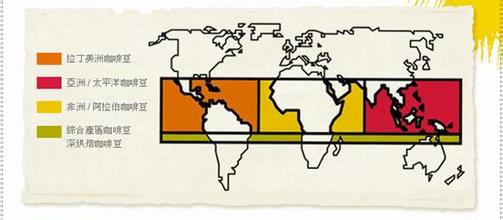Members of the Arabica and Robusta Arabica families of the two families of coffee beans
A hybrid of two families.
New World
"Mundo novo" bourbon had an affair with the iron pickup! There are illegitimate children in two families! It was first found in Brazil with high yield and strong disease resistance. The only drawback is that it can be more than 3 meters high and is not easy to harvest. Because of the good quality of cup test, it is regarded as the new hope of Brazilian coffee industry, so it is named New World.
Kaduai
"Catuai" Kaduai is a hybrid of New World and Kaddura. It inherits the advantage of Kaddura's low stature and makes up for the weakness of Arabica fruit. The result is solid, and it is not easy to fall when the strong wind blows. The biggest regret is that its overall flavor is slightly more monotonous than Kadura.
Kaduai also has the difference between red fruit and yellow fruit, and red fruit wins more often than yellow fruit. Kaduai, Kaddura, New World and bourbon are the four main varieties of coffee in Brazil.
Pacamara
The "Pacamara" Pacamara is the crystallization of the elephant bean of the iron pickup and the Pacas of the bourbon. It is also a hybrid, and the size of the bean is second only to the elephant bean. In 2007, he won the "CoE" championship of Guatemala and Honduras, and even arranged the top three awards of El Salvador, which is a rising star of El Salvador.
Bastards with turnips
Timo
"Timor" found the baby of Arabica and radish beans in East Timor, an island country at the eastern end of the Nusa Tenggara Islands. Timo, closer to Arabica. Timo has a low sour taste and lacks characteristics, so it is commonly used in Taiwan to make low-cost formula beans. Well, in terms of the importance of genes.
However, East Timor also has high-altitude pure Tibica treated with water. Before buying, it is important to find out whether it is a hybrid or a purebred iron card water washed beans, the quality of the two is very different, the former is mediocre, and the latter is amazing.
Katimo
"Catimor" in 1959, the Portuguese moved the bourbon variety Kaddura to East Timor and mixed it with Timo with radish bean pedigree to produce a second generation of mixed Katimo with strong disease resistance and yield.
Although Katimo inherits the strong advantages of radish beans, it also inherits genes with poor flavor. In recent years, botanists from all over the world have turned to the interbreeding of Arabica and Katimodo belts in an attempt to reduce the pedigree of radish beans in order to improve the bad reviews of the Katimo Cup.
Ikatu
"Icatu" in the past, Alabaster "Arabusta" mixed with Arabica and radish beans increased yield and disease resistance, but the flavor of coffee was not good all the time. Scientists crossed Arabica varieties with Arabica varieties such as Kaddura, New World and Bourbon for many generations, which gradually reduced the bad smell of radish beans and improved the aroma of Arabica beans, thus giving birth to an excellent variety of multi-generation hybrids-Icato.
In addition, the hybrids of Arabica and radish beans, such as "Ruiru 11", "Chandragiri" and so on, generally inherit the stout disease resistance of radish beans, but weaken the flavor of Arabica. For coffee lovers, whether these hybrids can perform satisfactorily or not remains to be further cultivated and tested.

Important Notice :
前街咖啡 FrontStreet Coffee has moved to new addredd:
FrontStreet Coffee Address: 315,Donghua East Road,GuangZhou
Tel:020 38364473
- Prev

Variants of the coffee bean iron pickup family, like Dou Kona Blue Mountain.
The variety of the iron pickup family, the elephant bean "Maragogype", was discovered in the "Maragogype" producing area of "Bahia" in northeastern Brazil in 1870, hence its name because the bean is at least three times larger than the average Arabica, making it the largest in the world. It is the most well-known variety of iron pickup beans, is the giant baby of the iron pickup family. Elephant beans are very suitable for the low altitude area of 700 meters and 800 meters, but the flavor
- Next

World coffee mocha mocha beans, mocha pot and espresso mocha coffee
The three meanings of Mocha in the coffee world the word Mocha has many meanings. Around 600 AD, the first coffee bean far from its hometown of Ethiopia took root in Yemen on the other side of the Red Sea, and the coffee industry began all over the world. Since the most important export port of Yemeni coffee in the early days was the port of Mocha, the coffee produced in Yemen was also called mocha beans.
Related
- Guji coffee producing area of Guji, Ethiopia: Humbela, Shakiso, Wulaga
- What is the most expensive variety of Qiloso in BOP multi-variety group?
- How to store the coffee beans bought home?
- Why are Yemeni coffee beans so rare now?
- Ethiopian Sidamo all Red Fruit Sun Sun Santa Vini Coffee beans
- SOE is mostly sour? What does it mean? Is it a single bean? what's the difference between it and Italian blending?
- Is Italian coffee beans suitable for making hand-brewed coffee?
- How to choose coffee beans when making cold coffee? What kind of coffee beans are suitable for making cold coffee?
- Just entered the pit to make coffee, what kind of coffee beans should be chosen?
- Can only Japan buy real Blue Mountain Coffee? What are authentic Jamaican Blue Mountain coffee beans?

